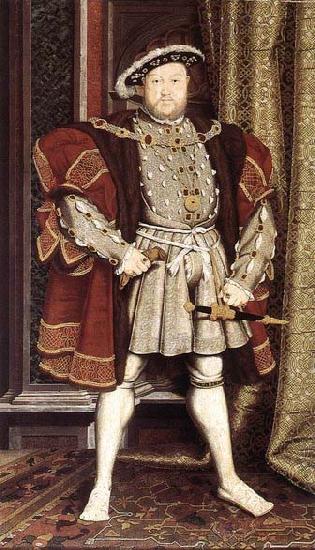Großhandels Europa Deutschland New Crafts International LLC in Europa
Henry VIII after
HOLBEIN, Hans the Younger
new21/HOLBEIN, Hans the Younger-447722.jpg
1537 Oil on canvas, 233,7 x 134,6 Walker Art Gallery, Liverpool The top job of Holbein, the court painter, was quite certainly to paint the king's portrait. In the 1530s, Henry VIII had enlarged his London residence Whitehall Palace, and needed a grand picture for it. It was to feature not only him and his wife Jane Seymour, but also his parents, the first Tudor monarchs, and was also intended to proclaim the fame of the ruling house in word and image. Since the composition probably adorned one wall of the Privy Chamber, a private chamber accessible only to more intimate members of court, the picture was not aimed at a broad public but a select group at court. No contract for the mural survives, but Henry VIII must have commissioned it in the short time during which he was married to Jane Seymour, in other words between May 30, 1536, and October 12, 1537. Both Catharine of Aragon and Anne Boleyn were already dead; in showing Jane together with Elizabeth of York and the Tudor monarchs in the picture, Henry's new connection was presented as the only legitimate one and the children of the marriage as the only rightful heirs. Possibly the picture was commissioned shortly after the wedding: in the surviving section of the cartoon a cartouche is included in the frieze, displaying the initials of Henry and Jane linked in a love knot. According to the copy by the painter Remigius van Leemput (1607-1675) in 1667, the cartouche on the mural as painted bore the date 1537. The picture shows a copy of the figure of Henry VIII from the left side of the mural which was destroyed in the Whitehall fire in 1698. Henry VIII stands in the foreground like a colossus with legs apart and knees straight. His broad shoulders, emphasized by his heavy clothing, exaggerate the already unusual physical presence of this large man, whose sex is additionally stressed by a prominent girdle and codpiece. The king thus appears as the epitome of vigour and potency. This stance, with legs apart and knees locked straight, is very uncommon for the portrait of a king. The reason may be that at the time spread legs were considered improper, as the Frankfurt scholar Jodocus Willich ( 1501-15 52) explains in a treatise on gestures first published in Basle in 1540. However, in visual art the stance was also associated with triumphant heroes; St. George, for example, can stand in a comparable pose after overcoming the dragon.Artist:HOLBEIN, Hans the Younger Title: Henry VIII Painted in 1501-1550 , German - - painting : portrait
Höhe
Breite
Zoll/CM
 |






